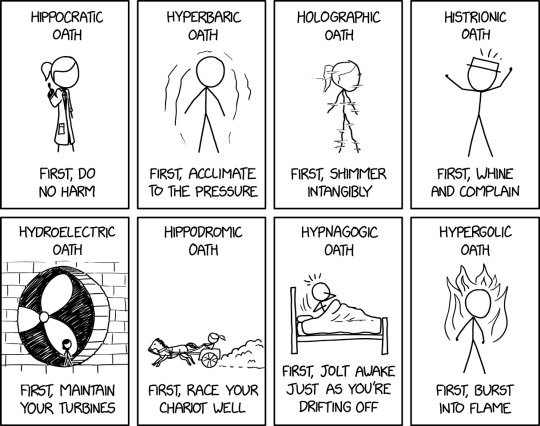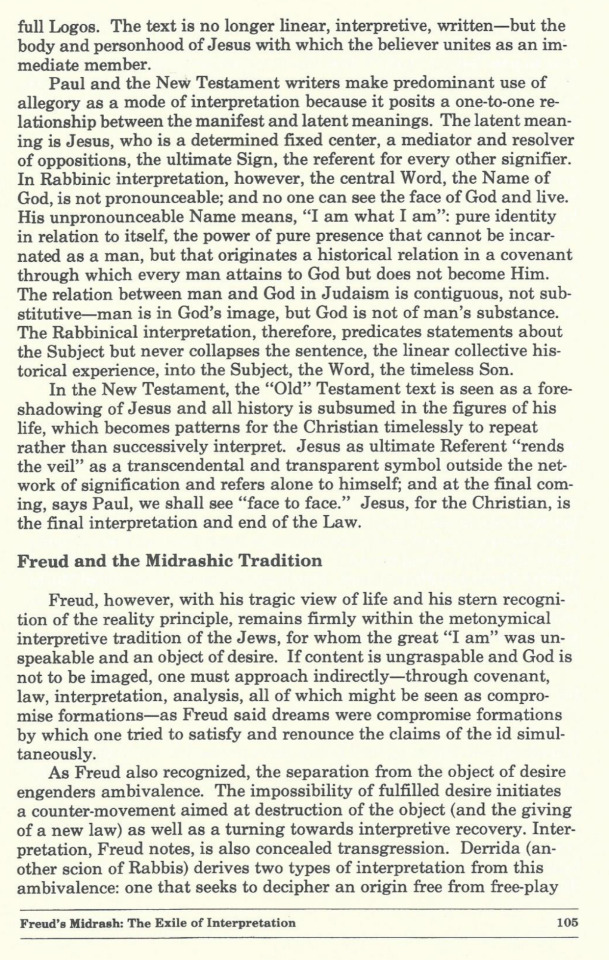#Hermeneutics
Text

Interpretations of the Hermeneutic Oath differ.
Professional Oaths [Explained]
Transcript Under the Cut
[8 Panels in a grid.]
Hippocratic Oath
[Ponytail in a doctor's coat with her arm raised in pledge.]
First, do no harm
Hyperbaric Oath
[Cueball shaking.]
First, acclimate to the pressure
Holographic Oath
[A hologram of Ponytail fitzing in parts.]
First, shimmer intangibly
Histrionic Oath
[White Hat yelling, fists upraised.]
First, whine and complain
Hydroelectric Oath
[Megan sat in the cut-out wall for a giant turbine.]
First, maintain your turbines
Hippodromic Oath
[Ponytail in a chariot pulled by a horse.]
First, race your chariot well
Hypnagogic Oath
[Cueball, half-risen from bed in shock.]
First, jolt awake just as you're drifting off
Hypergolic Oath
[Cueball on fire.]
First, burst into flame
#xkcd#professional oaths#xkcd 2843#webcomics#hippocratic oath#doctors#hyperbaric#holograms#histrionics#hydroelectric#turbines#chariots#hippodrome#hypnagogy#hypergolic propellant#hermeneutics
663 notes
·
View notes
Text
Proust, Joyce, Faulkner, Rilke, Lawrence, Gide…one could go on citing author after author; the list is endless of those around whom thick encrustations of interpretation have taken hold. But it should be noted that interpretation is not simply the compliment that mediocrity pays to genius. It is, indeed, the modern way of understanding something, and is applied to works of every quality. Thus, in the notes that Elia Kazan published on his production of A Streetcar Named Desire, it becomes clear that, in order to direct the play, Kazan had to discover that Stanley Kowalski represented the sensual and vengeful barbarism that was engulfing our culture, while Blanche Du Bois was Western civilization, poetry, delicate apparel, dim lighting, refined feelings and all, though a little the worse for wear to be sure. Tennessee Williams’ forceful psychological melodrama now became intelligible: it was about something, about the decline of Western civilization. Apparently, were it to go on being a play about a handsome brute named Stanley Kowalski and a faded mangy belle named Blanche Du Bois, it would not be manageable.
— Susan Sontag, from "Against Interpretation"
#susan sontag#sontag#lit#literature#against interpretation#proust#joyce#faulkner#rilke#lawrence#gide#hermeneutics#art#a streetcar named desire#elia kazan
31 notes
·
View notes
Text



Susan Handel, “Freud’s Midrash: The Exile of Interpretation”
20 notes
·
View notes
Text
Theories of the Philosophy of Literature
The philosophy of literature encompasses various theories that explore the nature, purpose, and significance of literature. Here are some prominent theories in this field:
Mimetic Theory: This theory, associated with Aristotle, suggests that literature imitates or reflects aspects of the real world. It focuses on the representation of human actions and characters.
Expressive Theory: This perspective emphasizes the expression of the author's emotions, thoughts, and experiences through literature. The work is seen as a medium for the author's self-expression.
Aesthetic Theory: Aesthetic theories, such as those by Immanuel Kant, focus on the intrinsic beauty and form of literature. They explore how literature provides aesthetic experiences and engages the imagination.
Reader-Response Theory: This theory considers the role of the reader in interpreting and giving meaning to a literary work. It suggests that meaning is not solely derived from the author's intentions but is co-created by the reader.
Structuralism and Semiotics: These theories, associated with figures like Roland Barthes, analyze the underlying structures and signs in literature. They explore how language and symbols create meaning.
Deconstruction: Developed by Jacques Derrida, deconstruction challenges fixed meanings in literature. It emphasizes the instability of language and the presence of multiple interpretations.
Feminist Literary Criticism: This approach examines literature through the lens of gender and challenges patriarchal norms. It explores how literature reflects and reinforces societal attitudes toward women.
Postcolonial Theory: Postcolonial literary criticism examines works in the context of colonialism and its aftermath. It explores how literature addresses issues of power, identity, and cultural representation.
Psychoanalytic Literary Criticism: Drawing from Freudian and Jungian theories, this approach explores the psychological dimensions of characters and narratives in literature. It delves into unconscious motivations and symbolism.
Ethical Criticism: Ethical theories in literature examine the moral implications and ethical choices presented in literary works. It considers how literature engages with ethical questions and influences readers' moral perspectives.
Cultural Criticism: Cultural theories analyze literature in the context of cultural practices, beliefs, and values. They explore how literature reflects and shapes cultural identities.
Narrative Theory: Narrative theorists examine the structure and function of narratives in literature. They explore how stories are constructed and how they contribute to our understanding of the world.
These theories offer diverse perspectives for interpreting and understanding the complexities of literature.
#philosophy#epistemology#knowledge#learning#chatgpt#education#Philosophy of Literature#Literary Theory#Literary Criticism#Hermeneutics#Aesthetics#Literary Interpretation#Reader-Response Theory#Deconstructionism#Feminist Literary Theory#Psychoanalytic Literary Theory#Postcolonial Literary Theory
19 notes
·
View notes
Text
Unicorns of the Bible

Job 39:9 (KJV) "Will the unicorn be willing to serve thee, or abide by thy crib?"
Job 39:10 (KJV) "Canst thou bind the unicorn with his band in the furrow? or will he harrow the valleys after thee?"
Psalm 92:10 (KJV) "But my horn shalt though exalt like the horn of an unicorn: I shall be anointed with fresh oil."
Deuteronomy 33:17 (KJV) "His glory is like the firstling of his bullock, and his horns are like the horns of unicorns: with them he shall push the people together to the ends of the earth: and they are the ten thousands of Ephraim, and they are the thousands of Manasseh."
Numbers 23:22 (KJV) “God brought them out of Egypt; he hath as it were the strength of an unicorn.”
Numbers 24:8 (KJV) “God brought him forth out of Egypt; he hath as it were the strength of an unicorn: he shall eat up the nations his enemies, and shall break their bones, and pierce them through with his arrows.”
Isaiah 34:7 (KJV) "And the unicorns shall come down with them, and the bullocks with the bulls; and their land shall be soaked with blood, and their dust made fat with fatness."
Psalm 29:6 (KJV) "He maketh them also to skip like a calf; Lebanon and Sirion like a young unicorn."
Note: When considering the most popular English translations of the Christian Bible - including the Hebrew texts, of which all of these verses originate- the King James Version (KJV) is considered to be one of the least accurate to the original language, despite using the Masoretic Hebrew as the reference text, which is used as the authorative Hebrew. No other popular translations use "unicorns." Instead, the reader will usually see "wild ox."
[I'm a seminarian who has several semesters of Biblical Greek and Hebrew]
#good omens#hermeneutics#gomens#noah's ark#unicorns#unicorns of the Bible#crowley#good omens season 1#gomens 1#gomens season 1#good omens 1#neil gaiman#bible#unicorn#oy shem
20 notes
·
View notes
Text
when biblical history comes up unexpectedly

#religious studies#bible study#theology#hermeneutics#religious memes#bible memes#religious history#cult core#cultcore
25 notes
·
View notes
Text
We cannot understand without wanting to understand, that is, without wanting to let something be said...Understanding does not occur when we try to intercept what someone wants to say to us by claiming we already know it.
~ Hans-Georg Gadamer
20 notes
·
View notes
Text
qsmp fandom is leagues better than dsmp ever was in terms of not being stupid about lore and discourse but i do still consistently see pov brainrot that is like so limited to this genre of media and does in fact suck. still better than anything that came before i think though
#bell.txt#i should bring that up to lumen maybe#like how pov brainrot impacts fandom & interpretation#hermeneutics#my beloved
11 notes
·
View notes
Text
"Webb is contending with white evangelicals who, for the most part, lack any coherent hermeneutic. Their defining approach to interpreting the Bible is to pretend it doesn’t require any interpretation."
2 notes
·
View notes
Text
Going to start referring to cumbrains as "Kinseyans," and insisting they accept different "interpretations" of the DSM-V so that it doesn't *really* deny the existence of pornography addiction.
Also going to note how the members of the governing bodies that determined the content of the DSM 5 were surrounded from youth by Hooters, Victoria's Secret, and adult video stores on all sides, so their denial of porn addiction needs to be placed in its proper cultural and historical context.
#Alfred Kinsey#dsm 5#DSM-5#Kinseyanity#Kinseyans#Addiction#addiction recovery#hermeneutics#Anthropology of religion#Secular creed#Secular cults#Fundamentalism#Not so funny once your reversed texts are put under the lens of historical criticism is it?#dsm#diagnostic statistical manual 5
5 notes
·
View notes
Quote
I still believe that I am right to claim that we must rigorously deny the possibility that human life can be lived without a future. For, as I see it, it is a distinctively human fact that we must always keep the future open and with it new possibilities. ... It is true that we cannot see paths and solutions in advance, and yet we must ask ourselves if there will not always remain new possibilities.
Hans-Georg Gadamer, The Enigma of Health, 80-81
69 notes
·
View notes
Text
Interpretation in our own time, however, is even more complex. For the contemporary zeal for the project of interpretation is often prompted not by piety toward the troublesome text (which may conceal an aggression), but by an open aggressiveness, an overt contempt for appearances. The old style of interpretation was insistent, but respectful; it erected another meaning on top of the literal one. The modern style of interpretation excavates, and as it excavates, destroys; it digs “behind” the text, to find a sub-text which is the true one. The most celebrated and influential modern doctrines, those of Marx and Freud, actually amount to elaborate systems of hermeneutics, aggressive and impious theories of interpretation. All observable phenomena are bracketed, in Freud’s phrase, as manifest content. This manifest content must be probed and pushed aside to find the true meaning—the latent content beneath. For Marx, social events like revolutions and wars; for Freud, the events of individual lives (like neurotic symptoms and slips of the tongue) as well as texts (like a dream or a work of art)—all are treated as occasions for interpretation. According to Marx and Freud, these events only seem to be intelligible. Actually, they have no meaning without interpretation. To understand is to interpret. And to interpret is to restate the phenomenon, in effect to find an equivalent for it. Thus, interpretation is not (as most people assume) an absolute value, a gesture of mind situated in some timeless realm of capabilities. Interpretation must itself be evaluated, within a historical view of human consciousness. In some cultural contexts, interpretation is a liberating act. It is a means of revising, of transvaluing, of escaping the dead past. In other cultural contexts, it is reactionary, impertinent, cowardly, stifling.
— Susan Sontag, from "Against Interpretation"
8 notes
·
View notes
Text
The origins of Lucifer (1/2)
Lucifer should first be understood as a reference to Venus. The "star" that appears after sunset and just before sunrise was called by Isaiah (14:12) hêlēl ben šaḥar, or "the shining one, son of dawn".
That was translated to Greek as ὁ ἑωσφόρος ὁ πρωὶ ἀνατέλλων, or "Heosphoros, raiser of morning". Heosphoros, in turn, means "bringer of morning", much like the common Greek name for Venus, Phosphoros, meant "bringer of light".
Lucifer is a direct translation of Heosphoros, or more precisely of Phosphoros: indeed, the Latin name translates to "bringer of light", rather than "bringer of morning".
It is notable that the Hebrew text speaks of a son of dawn and the Greek and Latin texts reference a bringer of dawn or light. (There were, of course, other ways of calling Venus among the Greco-Romans, notably reflecting the evening aspect of the planet: Catullus called it Noctifer.) At any rate, the astronomical reference was quite clear before Lucifer began being associated with the Devil.
#Lucifer#Venus#Heosphoros#Phosphoros#morning star#etymology#hermeneutics#theology#isaiah#religion#christianity
19 notes
·
View notes
Text
“[Pierre] Hadot's studies of the history of ancient philosophy and theology have always included the analysis of ‘the rules, the forms, the models of discourse,’ the framework of the literary genre whose rules are often rigorously codified, in which the thoughts of the ancient author are expressed. Such analysis is necessary in order to understand both the details of the work, the exact import of particular statements, as well as the general meaning of the work as a whole. Literary structure and conceptual structure must never be separated.
Describing his method of study for Latin Patristics, Hadot has invoked an exceptionally illuminating analogy, comparing what happens in these studies to what takes place in those curious paintings where
one sees at first sight a landscape that seems to be composed normally. One thinks that if there is, in such and such a place in the picture, a house or a tree it depends solely on the imagination of the artist. But if one looks at the whole painting from a certain angle the landscape transforms itself into a hidden figure, a face or a human body, and one understands then that the house or the tree was not there out of pure fancy, but was necessary because it made up part of the hidden figure. When one discovers the structure or the fundamental form of a text, one has an analogous experience: certain details that seemed to be there only in an arbitrary way become necessary, because they make up an integral part of the traditional figure used. And just as one can contrast or compare the sense of the face and the sense of the countryside, one can compare the meaning of the traditional form or structure, considered in themselves, and that of the text which has borrowed them… We often have the impression when we read ancient authors that they write badly, that the sequence of ideas lacks coherence and connection. But it is precisely because the true figure escapes us that we do not perceive the form that renders all the details necessary…once discovered, the hidden form will make necessary all of the details that one often believed arbitrary or without importance.”
— Arnold I. Davidson: Introduction to Philosophy as a Way of Life
2 notes
·
View notes
Text
Theories of the Philosophy of Expression
The philosophy of expression explores the nature, significance, and implications of human expression in various forms, including language, art, music, and body language. It delves into questions about the origins of expression, its relationship to identity, culture, and society, and its role in human communication and understanding. Additionally, it examines ethical and aesthetic considerations surrounding expression, as well as the philosophical frameworks that underpin different modes of expression.
The philosophy of expression encompasses various theories and perspectives that seek to understand the nature and significance of human expression. Some prominent theories include:
Mimetic Theory: This theory, proposed by Plato and Aristotle, suggests that art and expression imitate or reflect reality. It emphasizes the role of art in representing the natural world and conveying universal truths.
Expressivism: Expressivism posits that expression, particularly in language and art, serves as a means for individuals to express their inner thoughts, emotions, and experiences. It emphasizes the subjective and personal aspect of expression, focusing on the individual's unique perspective.
Semiotics: Semiotics, developed by Ferdinand de Saussure and Charles Peirce, explores the study of signs and symbols and their interpretation. It examines how meaning is conveyed through linguistic and non-linguistic signs, highlighting the role of context and cultural conventions in interpretation.
Pragmatism: Pragmatist philosophers like John Dewey emphasize the practical consequences of expression. They argue that expression serves a functional purpose in communication and problem-solving, shaping social interactions and facilitating collective action.
Hermeneutics: Hermeneutics focuses on the interpretation of texts and cultural artifacts, including literary works, religious texts, and artistic expressions. It examines the process of understanding and meaning-making, considering the role of context, tradition, and the interpreter's perspective.
Aesthetic Theory: Aesthetic theories, developed by philosophers like Immanuel Kant and Arthur Schopenhauer, explore the nature of beauty and artistic experience. They examine how aesthetic judgments are formed, the criteria for evaluating art, and the relationship between art and morality.
Phenomenology: Phenomenological approaches, as developed by Edmund Husserl and Maurice Merleau-Ponty, explore the lived experience of expression. They focus on the first-person perspective and the embodied nature of expression, examining how individuals perceive, interpret, and engage with the world through expression.
These theories offer diverse insights into the complexities of human expression, highlighting its multifaceted nature and its significance in shaping individual and collective experiences.
#philosophy#epistemology#knowledge#learning#chatgpt#education#ontology#metaphysics#psychology#Philosophy of language#Philosophy of art#Philosophy of music#Body language#Communication#Identity#Culture#Aesthetics#Ethics#Human experience#Mimetic theory#Expressivism#Semiotics#Pragmatism#Hermeneutics#Aesthetic theory#Phenomenology#Interpretation#Meaning-making
8 notes
·
View notes
